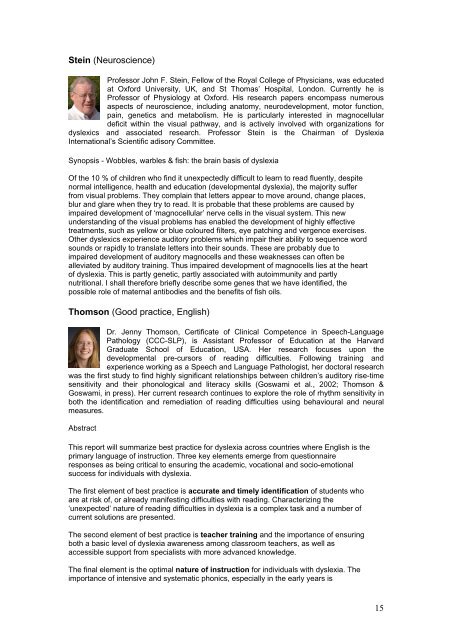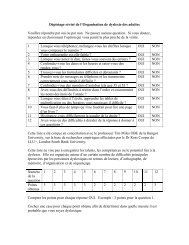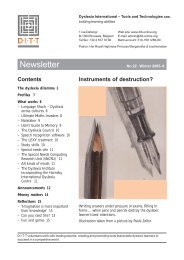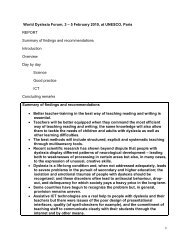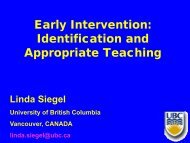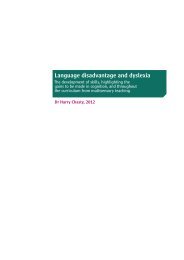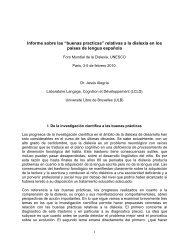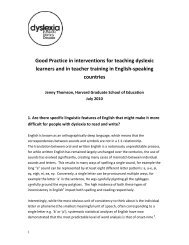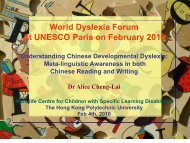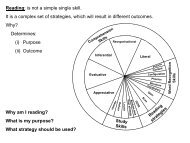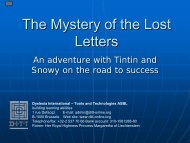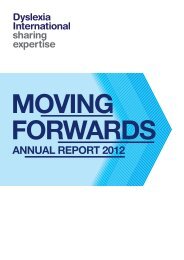Best practice in the teaching of reading and writing - Dyslexia ...
Best practice in the teaching of reading and writing - Dyslexia ...
Best practice in the teaching of reading and writing - Dyslexia ...
Create successful ePaper yourself
Turn your PDF publications into a flip-book with our unique Google optimized e-Paper software.
Ste<strong>in</strong> (Neuroscience)<br />
Pr<strong>of</strong>essor John F. Ste<strong>in</strong>, Fellow <strong>of</strong> <strong>the</strong> Royal College <strong>of</strong> Physicians, was educated<br />
at Oxford University, UK, <strong>and</strong> St Thomas’ Hospital, London. Currently he is<br />
Pr<strong>of</strong>essor <strong>of</strong> Physiology at Oxford. His research papers encompass numerous<br />
aspects <strong>of</strong> neuroscience, <strong>in</strong>clud<strong>in</strong>g anatomy, neurodevelopment, motor function,<br />
pa<strong>in</strong>, genetics <strong>and</strong> metabolism. He is particularly <strong>in</strong>terested <strong>in</strong> magnocellular<br />
deficit with<strong>in</strong> <strong>the</strong> visual pathway, <strong>and</strong> is actively <strong>in</strong>volved with organizations for<br />
dyslexics <strong>and</strong> associated research. Pr<strong>of</strong>essor Ste<strong>in</strong> is <strong>the</strong> Chairman <strong>of</strong> <strong>Dyslexia</strong><br />
International’s Scientific adisory Committee.<br />
Synopsis - Wobbles, warbles & fish: <strong>the</strong> bra<strong>in</strong> basis <strong>of</strong> dyslexia<br />
Of <strong>the</strong> 10 % <strong>of</strong> children who f<strong>in</strong>d it unexpectedly difficult to learn to read fluently, despite<br />
normal <strong>in</strong>telligence, health <strong>and</strong> education (developmental dyslexia), <strong>the</strong> majority suffer<br />
from visual problems. They compla<strong>in</strong> that letters appear to move around, change places,<br />
blur <strong>and</strong> glare when <strong>the</strong>y try to read. It is probable that <strong>the</strong>se problems are caused by<br />
impaired development <strong>of</strong> ‘magnocellular’ nerve cells <strong>in</strong> <strong>the</strong> visual system. This new<br />
underst<strong>and</strong><strong>in</strong>g <strong>of</strong> <strong>the</strong> visual problems has enabled <strong>the</strong> development <strong>of</strong> highly effective<br />
treatments, such as yellow or blue coloured filters, eye patch<strong>in</strong>g <strong>and</strong> vergence exercises.<br />
O<strong>the</strong>r dyslexics experience auditory problems which impair <strong>the</strong>ir ability to sequence word<br />
sounds or rapidly to translate letters <strong>in</strong>to <strong>the</strong>ir sounds. These are probably due to<br />
impaired development <strong>of</strong> auditory magnocells <strong>and</strong> <strong>the</strong>se weaknesses can <strong>of</strong>ten be<br />
alleviated by auditory tra<strong>in</strong><strong>in</strong>g. Thus impaired development <strong>of</strong> magnocells lies at <strong>the</strong> heart<br />
<strong>of</strong> dyslexia. This is partly genetic, partly associated with autoimmunity <strong>and</strong> partly<br />
nutritional. I shall <strong>the</strong>refore briefly describe some genes that we have identified, <strong>the</strong><br />
possible role <strong>of</strong> maternal antibodies <strong>and</strong> <strong>the</strong> benefits <strong>of</strong> fish oils.<br />
Thomson (Good <strong>practice</strong>, English)<br />
Dr. Jenny Thomson, Certificate <strong>of</strong> Cl<strong>in</strong>ical Competence <strong>in</strong> Speech-Language<br />
Pathology (CCC-SLP), is Assistant Pr<strong>of</strong>essor <strong>of</strong> Education at <strong>the</strong> Harvard<br />
Graduate School <strong>of</strong> Education, USA. Her research focuses upon <strong>the</strong><br />
developmental pre-cursors <strong>of</strong> read<strong>in</strong>g difficulties. Follow<strong>in</strong>g tra<strong>in</strong><strong>in</strong>g <strong>and</strong><br />
experience work<strong>in</strong>g as a Speech <strong>and</strong> Language Pathologist, her doctoral research<br />
was <strong>the</strong> first study to f<strong>in</strong>d highly significant relationships between children’s auditory rise-time<br />
sensitivity <strong>and</strong> <strong>the</strong>ir phonological <strong>and</strong> literacy skills (Goswami et al., 2002; Thomson &<br />
Goswami, <strong>in</strong> press). Her current research cont<strong>in</strong>ues to explore <strong>the</strong> role <strong>of</strong> rhythm sensitivity <strong>in</strong><br />
both <strong>the</strong> identification <strong>and</strong> remediation <strong>of</strong> read<strong>in</strong>g difficulties us<strong>in</strong>g behavioural <strong>and</strong> neural<br />
measures.<br />
Abstract<br />
This report will summarize best <strong>practice</strong> for dyslexia across countries where English is <strong>the</strong><br />
primary language <strong>of</strong> <strong>in</strong>struction. Three key elements emerge from questionnaire<br />
responses as be<strong>in</strong>g critical to ensur<strong>in</strong>g <strong>the</strong> academic, vocational <strong>and</strong> socio-emotional<br />
success for <strong>in</strong>dividuals with dyslexia.<br />
The first element <strong>of</strong> best <strong>practice</strong> is accurate <strong>and</strong> timely identification <strong>of</strong> students who<br />
are at risk <strong>of</strong>, or already manifest<strong>in</strong>g difficulties with read<strong>in</strong>g. Characteriz<strong>in</strong>g <strong>the</strong><br />
‘unexpected’ nature <strong>of</strong> read<strong>in</strong>g difficulties <strong>in</strong> dyslexia is a complex task <strong>and</strong> a number <strong>of</strong><br />
current solutions are presented.<br />
The second element <strong>of</strong> best <strong>practice</strong> is teacher tra<strong>in</strong><strong>in</strong>g <strong>and</strong> <strong>the</strong> importance <strong>of</strong> ensur<strong>in</strong>g<br />
both a basic level <strong>of</strong> dyslexia awareness among classroom teachers, as well as<br />
accessible support from specialists with more advanced knowledge.<br />
The f<strong>in</strong>al element is <strong>the</strong> optimal nature <strong>of</strong> <strong>in</strong>struction for <strong>in</strong>dividuals with dyslexia. The<br />
importance <strong>of</strong> <strong>in</strong>tensive <strong>and</strong> systematic phonics, especially <strong>in</strong> <strong>the</strong> early years is<br />
15


